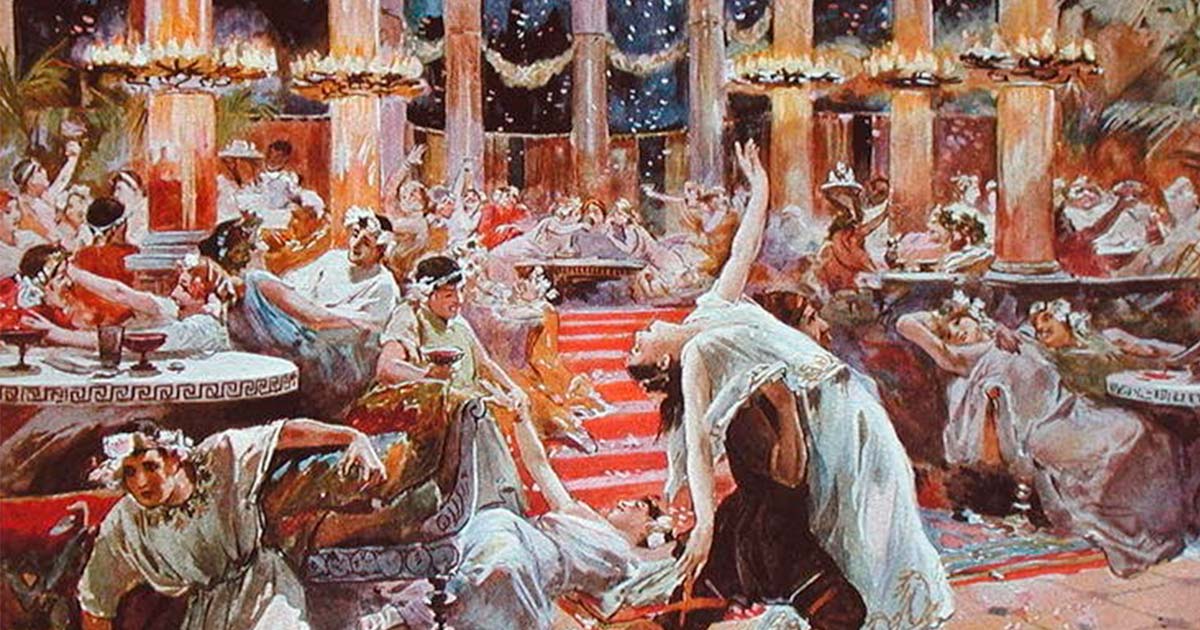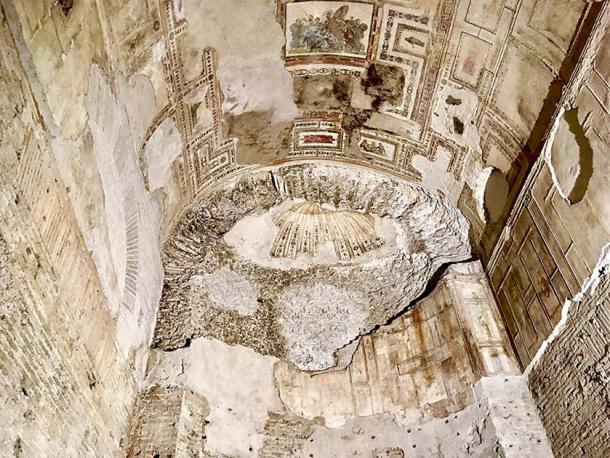The Revolving Dining Room of Emperor Nero Was A Real Place!

While the extravagant palace of Emperor Nero, the Domus Aurea—which boasted some 300 rooms covered in dazzling polished white marble—was first rediscovered during the Renaissance, in 2009 a team of French and Italian archaeologists made a stunning find. Their excavations uncovered an unexpected surprise: a revolving dining room which once served the illustrious guests of the infamous ruler.
Archaeologists called the 2,000-year-old revolving platform one of the most peculiar and sophisticated structures of antiquity. Curiously, the discovery of Nero’s revolving dining room confirms a description of the palace by ancient historian Suetonius.

Representational image of Emperor Nero and the burning city of Rome. (Alexander / Adobe Stock)
The Story of Nero; Tyrant and Roman Emperor
Nero was Emperor of Rome from 54 to 68 AD and the last in the Julio-Claudian Dynasty. He focused much of his attention on diplomacy, trade and enhancing the cultural life of the Roman Empire. Nevertheless, he was also well known for both his tyranny and his life of extravagance.
In 64 AD most of Rome was destroyed in the Great Fire of Rome, which many Romans believed Nero himself had started in order to clear land for his planned palatial complex. Apart from being an early persecutor of the Christians, he was infamously known as the Emperor who “fiddled while Rome burned.” He was responsible for many executions, including that of his mother, wife and, most likely, his stepbrother Britannicus.

Interior from the Domus Aurea, or Golden Palace, where Nero’s revolving dining room was discovered. (Andy / CC BY-SA 2.0)
Nero’s Golden Palace in Rome
The construction of Nero’s palace began soon after the great fire had cleared away the aristocratic dwellings on the slopes of the Palatine Hill. The Domus Aurea was built of brick and concrete in the few years between the fire and Nero’s suicide in 68.
The extensive gold leaf that gave the villa its name was not the only extravagant element of its decor: stuccoed ceilings were faced with semi-precious stones and ivory veneers, while the walls were frescoed, coordinating the decoration into different themes in each major group of rooms.
Historian Suetonius wrote a vivid description of the palace in the Lives of the Caesars, Nero:
“Its vestibule was large enough to contain a colossal statue of the emperor a hundred and twenty feet high; and it was so extensive that it had a triple colonnade a mile long. There was a pond too, like a sea, surrounded with buildings to represent cities, besides tracts of country, varied by tilled fields, vineyards, pastures and woods, with great numbers of wild and domestic animals. In the rest of the house all parts were overlaid with gold and adorned with gems and mother-of-pearl. There were dining-rooms with fretted ceils of ivory, whose panels could turn and shower down flowers and were fitted with pipes for sprinkling the guests with perfumes. The main banquet hall was circular and constantly revolved day and night, like the heavens. He had baths supplied with sea water and sulphur water. When the edifice was finished in this style and he dedicated it, he deigned to say nothing more in the way of approval than that he was at last beginning to be housed like a human being.”
The description appeared so over-the-top that modern-day historians were highly doubtful that it accurately reflected the actual palace. However, the latest discovery suggests that Suetonius’ description was at least partially correct.
The Modern-Day Discovery of Nero’s Revolving Dining Room
While conducting excavations at Nero’s famed Domus Aurea in Rome, archaeologists came across their remarkable discover. During digs on an artificial terrace on the northeast corner of Rome’s Palatine Hill they found a round, 12-metre-high (39.4 ft) tower, with a large central pillar of four meters (13.12 ft) in diameter and eight pairs of arches supporting two floors.
Along the top of the upper arches, were lines of semi-spherical holes, filled with slippery clay—somewhat like the cavities that were used on large ships to contain primitive ball bearings, on which moveable platforms were mounted to transport heavy loads.
The lines of cavities in the structure are believed to have housed metal spheres that supported the revolving floor. At the bottom of the tower, archaeologists also found indications that a mechanism had been built into the wall. Calcite deposits on the surrounding stones suggest that the floor’s constant movement may have been powered by water channeled through a system of gears.

A reconstructive model of the system of spheres on which Nero’s revolving restaurant rotated. (Francoise Villedieu and Edikom)
“This cannot be compared to anything that we know of in ancient Roman architecture,” said lead archaeologist Francoise Villedieu. They declared the remains were probably all that was left of Nero’s legendary revolving dining room—a circular space designed to rotate continuously, mirroring the Earth’s movement and captivating his guests. This would have made it an engineering marvel of its time.
Maria Antonietta Tomei, an archaeologist and former official for the Culture Ministry’s Archaeological Superintendency, which supervised the dig on the Palatine, said the discovery of the dining room was able to shed new light on the Emperor Nero.
Despite Nero’s terrible reputation, “he was not just a negative figure,” explained Tomei in an article published in Haaretz. In her view, the mechanical and architectural sophistication of his revolving dining room highlight his passion for science and technology as well as for the arts and culture.